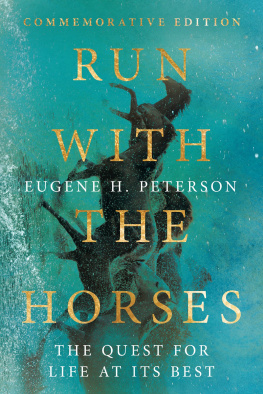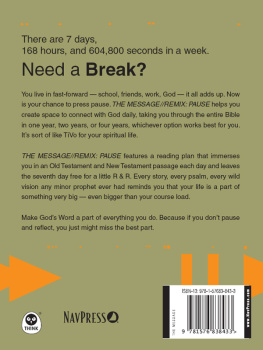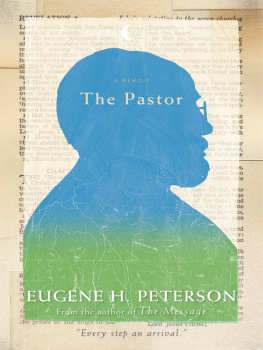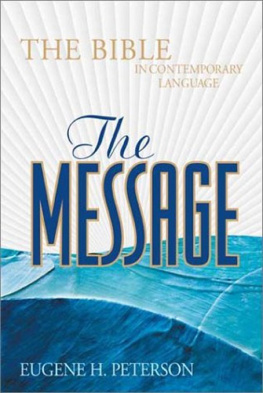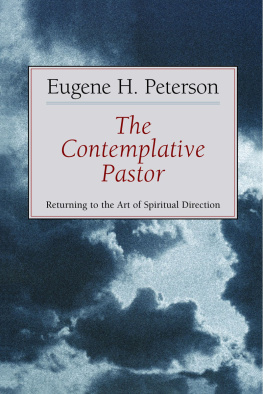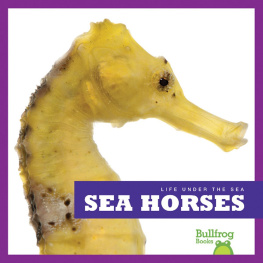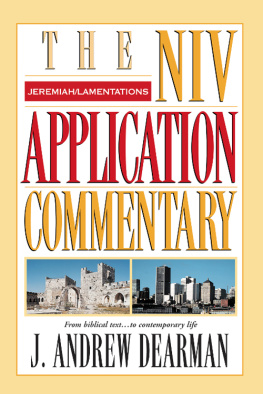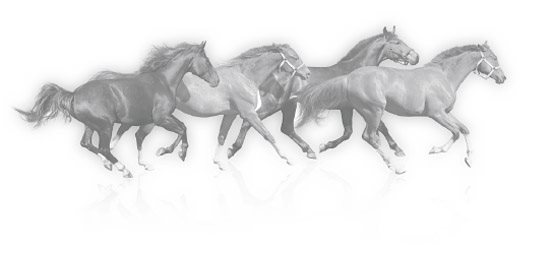Table of Contents
Pagination de ldition papier
Guide
Ill run the course you lay out for me
if youll just show me how.
PSALM 119:32
InterVarsity Press
P.O. Box 1400, Downers Grove, IL 60515-1426
ivpress.com
Commemorative Preface 2019 by Eric E. Peterson
Second edition 2009 by Eugene H. Peterson
First edition 1983 by Inter-Varsity Christian Fellowship of the United States of America
All rights reserved. No part of this book may be reproduced in any form without written permission from InterVarsity Press.
InterVarsity Press is the book-publishing division of InterVarsity Christian Fellowship/USA, a movement of students and faculty active on campus at hundreds of universities, colleges, and schools of nursing in the United States of America, and a member movement of the International Fellowship of Evangelical Students. For information about local and regional activities, visit intervarsity.org.
Scripture quotations, unless otherwise noted, are from THE MESSAGE, copyright 1993, 1994, 1995, 1996, 2000, 2001, 2002 by Eugene H. Peterson. Used by permission of NavPress. All rights reserved. Represented by Tyndale House Publishers, Inc.
While any stories in this book are true, some names and identifying information may have been changed to protect the privacy of individuals.
The poem What I had not foreseen, found on p. 31, is from Collected Poems 1928-1953 by Stephen Spender, copyright 1934 and renewed 1962 by Stephen Spender. Reprinted by permission from Random House, Inc., and Faber and Faber, Ltd.
Cover design: David Fassett
Interior design: Cindy Kiple
Cover images: blue watercolor background: kentarcajuan / E+ / Getty Images
powder burst: Qiang Fu / Moment / Getty Images
gold glitter background: MirageC / Moment / Getty Images
wild horses: tunart / E+ / Getty Images
ISBN 978-0-8308-5548-3 (digital)
ISBN 978-1-5140-0616-0 (print)
This digital document has been produced by Nord Compo.
For Eric
also the son of a priest
Commemorative Preface
A Homily for the Celebration of the
Resurrection of Eugene Peterson
ERIC E. PETERSON
We carry this precious Message around in the unadorned
clay pots of our ordinary lives. (The Message)
But we have this treasure in clay jars. (NRSV)
2 CORINTHIANS 4:7
Praise God from whom all blessings flow.
Ive been thinking a lot about containers these days.
It brought to mind an ancient proverb that tells the story of a young girl whose morning chore it was to walk to the river and fetch water for her household. Suspended from a pole across her shoulders were two water pots that supplied her familys daily needs. One of the pots was perfect, but the other one was cracked, and by the time they made the return trip home each day, the second pot was only half full.
After some time, the little cracked pot, ashamed that she wasnt able to function at full capacity, expressed her embarrassment and sense of failure to the girl. Why do you keep using me when all I do is leak? she asked. Why dont you replace me with a new pot?
Smiling, the girl gently responded, Have you seen the beautiful flowers that grow along the path between the house and the river? And have you noticed that they only grow on your side of the path as we walk home together? Thats because every spring I plant seeds on only your side, knowing that you will water them as we walk home together. Ive been picking those flowers for years and filling our home with fragrance and beauty. I couldnt do it without you. What you thought was a flaw is actually a gift to us all.
In ways that continue to astound me, God consistently chooses to accomplish divine purposes through the agency of human imperfection. Through the weaknesses and shortcomings of the clay potswhich are our livesuncommonly beautiful things emerge.
Praise God from whom all blessings flow.
The message of Gods love, this magnificent story of creation, salvation, and liberation, has been entrusted to the unadorned clay pots of our ordinary lives (2 Cor 4). In other words, the container of good news is the broken body of Christ. Were a bunch of crack pots. We leak. This is by design. So that the blessings might flow.
One of the most important things Eugene taught us is that everything about the life of faith is livable. If you cant translate an idea into an experience, its not gospel. Abstractions are enemies of the Way of Truth and Life.
Which is why Im so very grateful to have grown up with a man whose life was so well integrated and congruent, such that the dad who served up mashed potatoes on Saturday night was the very same pastor who served up the word of God on Sunday morning. He was someone who embodied the message he proclaimed. His body was a sacred temple. A habitation for the holy. A container of the Spirit of God.
I know this to be true because the evidence is irrefutable, inasmuch as he manifested the fruits of the Spirit.
He was a container for love, joy, peace, patience, kindness, goodness, faithfulness, gentleness, and self-control.
He was a flawed and cracked container of these gifts, never hoarding, always leaking. What a holy vessel he was. Praise God from whom all blessings flow.
Moreover I think of his many books as durable containers of the words he wrote for us. Inspired words full of truth and grace. Words that we will treasure for many years.
But for right now I wish to draw your attention to two particular containers that are here. They are common enough as containers go. What is unusual is that they are in the same room at the same time.
A cradle. And a casket.
The one is a container of life. The other is a container of death.
One is open to the world; the other, closed, having finished this world.
The one holds promise and hope and future. Anticipation. The other holds completion: it is finished.
The one represents a glorious beginning; the other, a glorious end.
A cradle and a casket: these are the containers that bookend our lives.
When Eugene delivered this cradle, freshly crafted from his basement workshop in Maryland to New Jersey, where his first grandchild was born, I exclaimed to him how beautiful it was. As we were carrying it into the apartment together he confessed that it had a flaw, and he had to shim it. I knew all about shims because he had taught me, at an early age, about them. Every carpenter, he said, needs to know how to use shims.
I have scrutinized this cradle over the years, and I still cant find the flaw. He wasnt just a master word-worker; he was a master woodworker.
And among the things he left us, in the craft of words and wood, is this exquisite piece of work that our family will treasure for generations. Many of Eugenes grandchildren and grandnephews and grandnieces were held in this little container, and their names are all inscribed inside.
This all came back to mind as I was building his casket a couple of weeks ago. The miter joints werent lining up exactly right, and I had to use some shims to tighten them up. I had never built a casket before, and so I set out doing what many of us have learned to do: I went to YouTube. And in the process, I came across a coffin maker named Marcus Daly, who doesnt just build wooden boxes but contemplates the human condition. I very much like the way he reflects on his work. Here is what he says:
I think one of the most important aspects of the coffin is that it can be carried. And I think were meant to carry each other. And I think carrying someone you love, committing them, is very important for us when we deal with death. We want to know that we have played a part and that we have shouldered our burden. So, if we make it too convenient, then were depriving ourselves of a chance to get stronger so that

